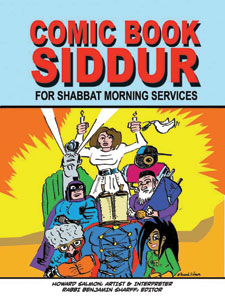“COMIC BOOK SIDDUR FOR SHABBAT MORNING SERVICES,” by Howard Salmon (Comicbooksiddur.com, $24.95) Once upon a time, Hebrew schools operated on the assumption that a working knowledge of Hebrew was such a basic skill for Jewish youngsters that they would be eager to learn it no matter how dry and formal the presentation. However, in our time, when young people live in a world where they are bombarded by all sorts of dynamic visual imagery, the traditional textbook is as outmoded as an eight-track tape. Publishers of Hebrew texts, like those of secular texts, must strive for excitement in order to compete.
Once upon a time, Hebrew schools operated on the assumption that a working knowledge of Hebrew was such a basic skill for Jewish youngsters that they would be eager to learn it no matter how dry and formal the presentation. However, in our time, when young people live in a world where they are bombarded by all sorts of dynamic visual imagery, the traditional textbook is as outmoded as an eight-track tape. Publishers of Hebrew texts, like those of secular texts, must strive for excitement in order to compete.
While the title of “Comic Book Siddur” suggests that it is a prayer book, it clearly is intended more for study — specifically for pre-Bar/Bat Mitzvah study — than for use in a service. First of all, we should note that it is oriented toward the Reform liturgy, specifically Mishkan Tefilah, with its inclusion of the matriarchs in the opening section of the Amidah and the gender-neutral Elohei dororteinu in the Modim and its treatment of the Shema (omitting the verses from Deuteronomy which traditional Jews consider to be part of the Shema itself.)
The reason I say it would be of use more as a study tool than during a service is that it includes the entire text of the prayers in Hebrew, the English is only a summary, whereas most Reform congregations conduct much of the service in English.
What makes this book unique is the way in which the material is presented. Each Hebrew prayer is accompanied by one or more comic-book illustrations with some words giving an interpretation of the text or its place in the service. For example, the Chatzi Kaddish, which serves as a transition in the service, is accompanied by a picture of a super-hero proclaiming, “C’mon, team. We’ve got a date with destiny! We’re meeting God, so get yourselves ready.” The Shema tells us “God is Real! Forever! Don’t be fooled by imitations.” For the V’Ahavta, a cute bear tells us to “Give God a hug.”
The entire text, in fact, represents the progress of a group of superheroes bent on saving the planet. In particular, Captain Aleph tells us that he is on his way toward becoming a man by studying for his Bar Mitzvah.
Though roughly based on the type of super-heroes familiar to those readers familiar with the comic-book genre, the characters are original and not identifiable with any particular such heroes. The opening, however, clearly refers to the Superman myth, with its unmistakable parallels to the story of Moses in the Nile — in case anyone missed that point in the first Superman movie.
The principal message of this book, perhaps its raison d’etre, is that the traditional liturgy can be relevant and even exciting, that even superheroes can find it stimulating. Hopefully, this message will get across to its readers.
You don’t have to take my word for it — you can see samples at www.comicbooksiddur.com. If you like what you see, this could make an excellent birthday gift for the 12 year old on your shopping list. Anyway, my 10-year-old granddaughter thinks it’s “cool.”


